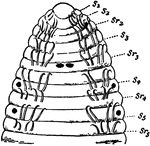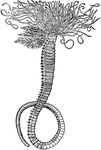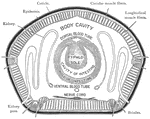This gallery offers 156 ClipArt images of worms. Worms are a general term given to many invertebrate animals that have a long, soft body and no legs.

Sectional View of Acanthobdella
An illustration of a sectional view of a Acanthobdella, a member of the annelid family. "c, Coelom;…
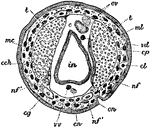
Sectional View of Acanthobdella
An illustration of a sectional view of a Acanthobdella, a member of the annelid family. "c, Coelom;…
Wheel, animalcule
"These animals [the Rotifera], called Wheel Animalcules, were formerly included among the Infusoria,…
Annelid
This diagram shows a fresh-water annelid. a, appendages; br., brain; d, dissepiments; i, intestine;…

Annelid
This diagram shows the longitudinal section of the anterior end of the annelid. A, sagittal section;…
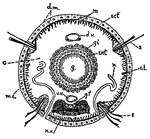
Annelid
This diagram shows a transverse section of dero. c., caelom; c.l., cells of the so-called "lateral line";…
Leodice antennata
"The Leodice antennata has the organs of locomotion attached to each segment; they are usually…
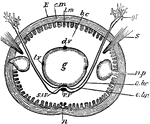
Arenicola
"Cross-section of Arenicola. E., Epidermis; c.m., circular muscles; l.m., longitudinal muscles; b.c.,…
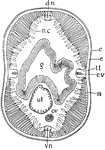
Ascaris
"Cross-section through Ascaris. d.n., Dorsal nerve; n.c., non-contractile portion of muscle cells; c.,…
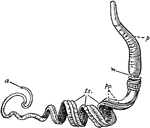
Balanoglossus
"Male of Balanoglossus (Dolichoglossus) kowalevskii. Note anterior proboscis. Mo., Mouth; op., slight…

Bladder-Worms
"Diagrams of bladder-worms. I. The ordinary Cysticercus type with one head (H.). II. The Coenurus type,…

Blood Circulation
This illustration shows a representation of the circulation of the blood, in its essential features.…

Bonellia Viridis (Female)
Illustration of a female green spoonworm. A, Proboscis cut short; B, bristle passing though the mouth…
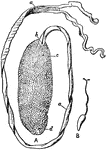
Bonellia Viridis (Male)
Illustration of a male green spoonworm. A, Bonellia viridis; B, mouth; C, ventral hooks; and d, anus.…

Bonellia Viridis (Male)
Illustration of a male green spoonworm. A, Generative pore with spermatozoa; B, Anterior blind end of…
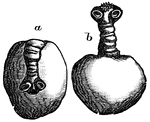
Cestode
"Bladderworm stage of a Cestode...a, Early stage with head inverted. b, Later stage with head everted."…
Chaetognatha
Chaetognatha is a phylum of predatory marine worms that are a major component of plankton worldwide.…
Circulatory System of an Annelid
Anterior part of the circulatory system of an annelid. The arrows indicate the direction of the flow.…
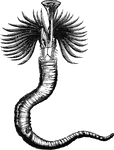
Serpula contortiplicata
"The Serpulae, which form irregularly twisted calcareous tubes, often grow together in large…

Dasychone Infracta
An illlustration of a dasychone infracta, a type of annelid. The annelids, collectively called Annelida…
Demoscolecida
"Demoscolecida, a group of minute marine worm-like creatures. The body tapers towards each end and is…
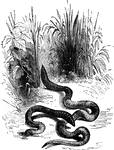
Earth-worms
"The bodies of these animals are of a cylindrical form, somewhat pointed at the anterior extremity,…
Earthworm
The earthworm works through the ground by insinuating its pointed head between the grains of dirt, (Hooker,…

Earthworm
Dorsal view of internal structures of earthworm after cutting through the dorsal wall lengthwise and…

Earthworm
"Transverse section of the intestine of the Earthworm. ty, typhlosole, an infolded longitudinal ridge…
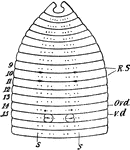
Earthworm
"Anterior region of earthworm. Note the eight setae (s.) on each segment. R.S., Spots between 9-10,…
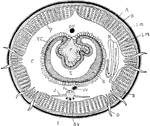
Earthworm
"Transverse section of earthworm. A., Cuticle; B., epidermis; C.M., circular muscles; L.M., longitudinal…

Earthworm
An illustration of an earthworm. The basic body plan of an earthworm is a tube, the digestive system,…
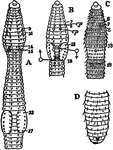
Earthworm
"Diagrams of various earthworms to illustrate external characters. A, B, C, anterior segments from the…
Earthworm
The earthworms are also known as megadriles, in the families Tubificidae, Lumbriculidae, and Enchytraeidae,…

Earthworm Anatomy
The earthworms are also known as megadriles, in the families Tubificidae, Lumbriculidae, and Enchytraeidae.…
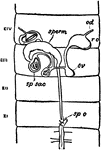
Female Earthworm Reproductive System
An illustration of the reproductive system of a female earthworm which is located in the eleventh to…
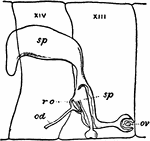
Female Earthworm Reproductive System
An enlargement of the reproductive organs of a earthworm. "sp, Spermatheca; sp',Spermathecal sac involving…
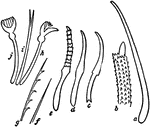
Setae of Earthworm
An illustration of the various types of earthworm setae. Seta (plural: setae) is a biological term derived…

Dicyemennea Eledones Worm Found in Kidney of Octopus
A cross sectional view of the Dicyemennea Eledones, a parasite, found in Eledone Moschata, or musky…

Euchone
Euchone elegans is a species of marine worms in the family, Terebellidae, sometimes known as spaghetti…
Flatworm
Flatworms are flattened, leaf-like forms living in damp places on land, in freshwater streams of ponds,…
Flatworm
Flatworms are flattened, leaf-like forms living in damp places on land, in freshwater streams of ponds,…

Flatworm
Flatworms are flattened, leaf-like forms living in damp places on land, in freshwater streams of ponds,…
Flatworm
Flatworms are flattened, leaf-like forms living in damp places on land, in freshwater streams of ponds,…
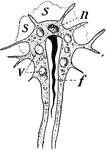
Flatworm
Flatworms are flattened, leaf-like forms living in damp places on land, in freshwater streams of ponds,…

Flatworm
Flatworms are flattened, leaf-like forms living in damp places on land, in freshwater streams of ponds,…
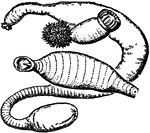
Gephyrea
Gepyrea is a name formerly given to a class of worms which included three families: (1) Priapulidae;…
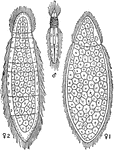
Rhopalura Gairdii Flat Worm
Illustration showing different rhompalura gairdii flat worms. The left and the right worms are the female,…

Gills (worm)
This illustration shows a transverse section of a worm with external gills. Gills are the breathing…

Gordian Worm
"The Young Variable Gordius, after escaping from the egg. a, the worm beginning to protrude the oral…

Gordian Worm
"The Young Variable Gordius, after escaping from the egg. b, the first circle of hooklets bordering…

Gordian Worm
"The Young Variable Gordius, after escaping from the egg. c, complete protrusion of both circles of…
